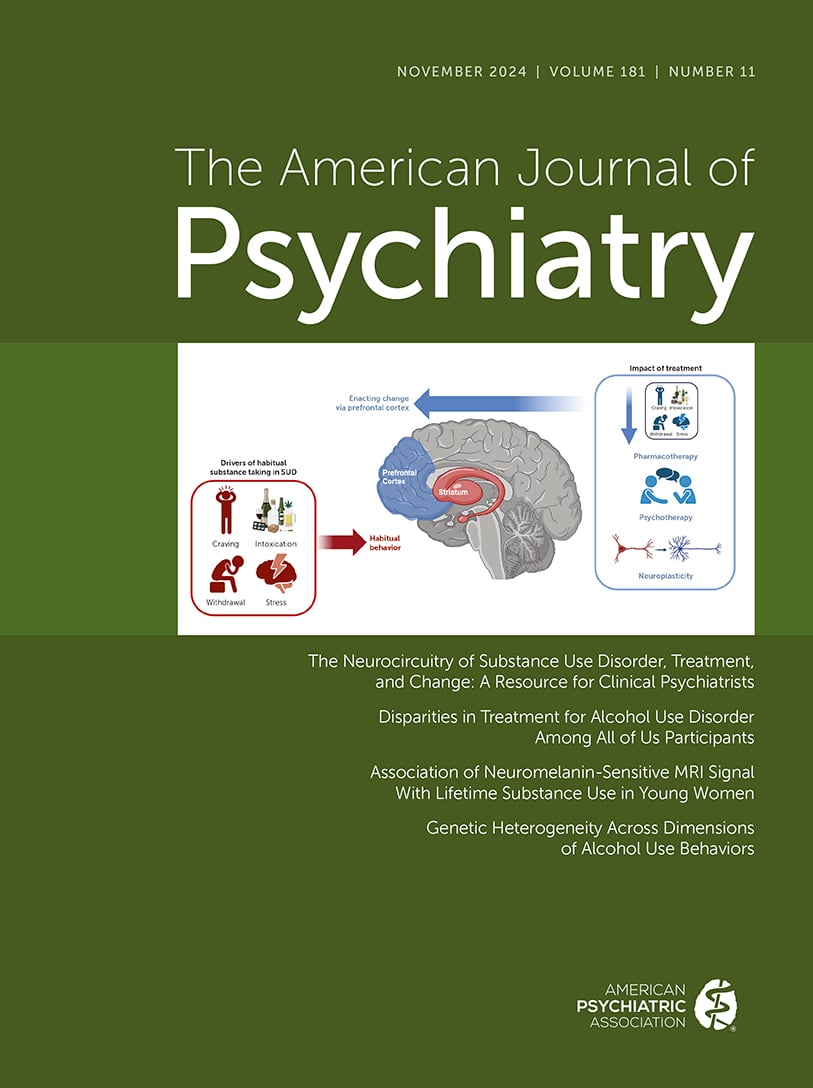Given the very high overdose death rates from opioids and stimulants and the increasing rates of cannabis use and use disorders among adults in the United States (
1,
2), developing new medications and other treatments for substance use disorders is an urgent need. Unfortunately, the main outcome currently used for U.S. Food and Drug Administration (FDA) approval of medications to treat substance use disorders other than alcohol use disorder is abstinence, which is a very hard bar to reach. While achieving continuous abstinence has been documented to be clinically beneficial, such an outcome is difficult to achieve or sustain and is made particularly challenging as the brain circuits involved with self-regulation and stress reactivity have been compromised by drug use (
3). Moreover, the weakening of social and economic support systems that many people with substance use disorders face imposes further barriers to abstinence. Such a difficult-to-achieve outcome has deterred the development of new agents to treat substance use disorders (
4). Thus, identification of alternative meaningful outcomes with evidence of clinical benefit could increase successful development of new treatments to help patients even when not resulting in continuous abstinence (
5).
For the alcohol field, strong evidence shows that reductions in the quantity and frequency of alcohol used, regardless of total abstinence, leads to improved health (
6). In response, the FDA allows increases in the percentage of subjects with no heavy drinking days as an alternative to abstinence as a main outcome for medication trials to treat alcohol use disorder. Less information is available on the benefits of reduced frequency or intensity as related to other substances.
The risks of morbidity and mortality associated with every episode of illicit drug use, particularly with fentanyl’s current intrusion into illicit drug markets, pinpoints why a reduction in the frequency of illicit drug use could be clinically meaningful (
4). Furthermore, researchers have also shown that nonabstinent reductions in use of stimulant drugs are associated with improvements in clinical outcomes (
7,
8). As researchers and clinicians work to improve treatment outcomes for persons with substance use disorders, accumulating evidence points toward the benefits of both abstinence and nonabstinence reductions in quantity and frequency of drug use as scientifically justified endpoints (
9–
11). These are the issues addressed for cannabis use disorder in the article by McClure and colleagues in this issue of the
Journal (
12).
McClure and colleagues conducted a secondary analysis of clinical trials that focused on treating cannabis use disorder to determine 1) whether decreases in self-reported cannabis use were associated with improvements in cannabis-related problems and functional outcomes, and 2) if so, what percentage decrease in cannabis use is needed for meaningful improvement. The study’s exploratory analyses showed that among individuals age 18 and older undergoing treatment for cannabis use disorder, reductions in cannabis use falling short of total abstinence were associated with clinically meaningful improvement in “cannabis-related problems and functional outcomes.” The study used data from seven treatment studies conducted in the United States with a total combined sample of 920 persons and examined a range of outcomes (the self-reported Marijuana Problems Scale, the Health-Related Quality of Life scale, and the Pittsburgh Sleep Quality Index, as well as the clinician-rated Clinical Global Impressions severity scale). A key question that the investigators explored empirically was to use multivariable classification models to determine the levels of cannabis use reduction that were most strongly associated with improved outcomes. They found that reductions of approximately 50% in days of use and 75% in use amounts were associated with maximum improvements on the clinician-rated Clinical Global Impressions scale.
The exploratory nature of the McClure et al. study is related to the fact that none of the randomized clinical trials used for the study prespecified these outcomes in their plans. In addition, assessment of outcome improvement was developed based on a consensus approach, suggesting that future methodological studies of the measures of quantity of cannabis consumed are indicated. All study subjects were from a single research center, and the data were not designed to be consistent across all studies, which limited sample size for many of the tests. Despite these acknowledged limitations, McClure and colleagues provide data that should influence many other studies.
The implications of McClure and colleagues’ findings for medication development in general and for cannabis use disorder in particular are significant. For instance, FDA approval of medications for the treatment of substance use disorders other than alcohol has required abstinence outcomes in treatment studies, despite the FDA’s potential acceptance of nonabstinence outcomes as additional evidence in support of approval (
13). To consider other outcomes (i.e., less than total abstinence) as the main outcome for FDA approval, a key need for the field is to conduct studies that document that such outcomes are associated with clinically meaningful improvements. McClure and colleagues’ study provides first-time evidence that reductions in cannabis use were beneficial to patients with a cannabis use disorder.
As there are very few FDA-approved medications for substance use disorders and none for cannabis or stimulant use disorders, a more nuanced understanding of how to achieve therapeutic benefit short of periods of total abstinence will facilitate the development of new treatments and in the process save lives and potentially help many patients recover. In this respect, McClure and colleagues’ findings build evidence toward new pathways to help medication development for cannabis use disorders. A primary strength of the study was its goal of establishing measures of reductions in cannabis use associated with meaningful improvements in clinical outcomes, including estimates of the minimum reductions necessary to improve outcomes. This is a first step to defining the requirements for a meaningful reduction in cannabis use—a finding that future studies can further assess and expand by including unit doses of delta-9-tetrahydrocannabinol (THC) (
13). The increases in adverse consequences from cannabis use and use disorders and the lack of available treatments highlight the urgency of such work (
2,
4,
14).

